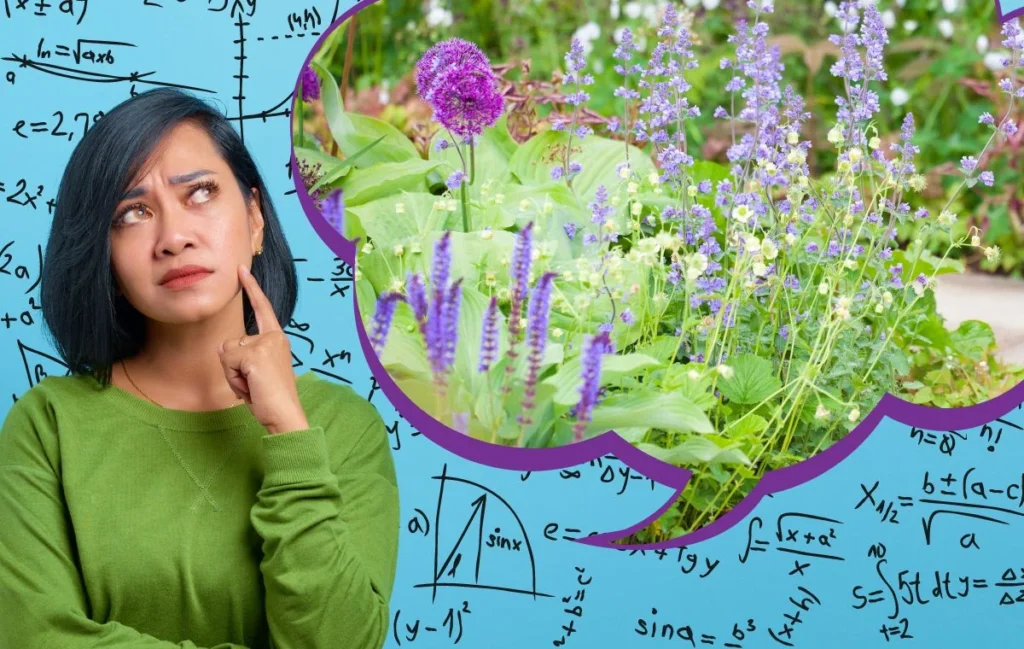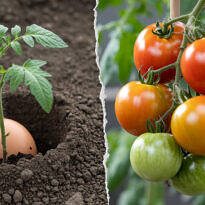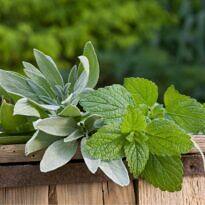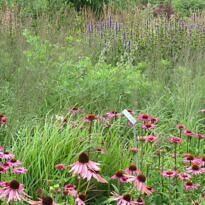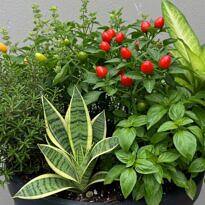If there is one science that always complicates things for landscapers and gardeners, it is definitely spacing.
Have you ever been unsure about what spacing to use in your flower beds, plant clusters, or rows? And what about when the plants in the bed are of different species? That complicates things even more.
But don’t despair, this article will help you permanently eliminate this doubt from your mind and make your calculations easier when buying plants for the garden.
First, understand that although we have spacing recommendations for certain species already established, the spacing between plants can vary according to several factors, and there is no exact rule. Among these factors, we should consider:

- Water Availability: Moist soils or those with ample irrigation allow for denser planting than those where water is scarce.
- Natural Fertility: Fertile soil can support more plants than poor soil. This factor can obviously be improved in well-managed and amended gardens.
- Solar Orientation: In areas that receive full sun, plants that tolerate or need more sunlight can be spaced closer together, as they tend to seek light above lateral expansion. In contrast, in shaded areas, a wider spacing can help in capturing available light.
- Genetic Potential: Within the same species, there will be larger and smaller plants, as well as plants with greater adaptive potential than others, more elongated plants versus more rounded plants, etc. We must then consider the cultivar and its potential before choosing the best spacing.
- Time for Formation: It’s true that some gardens may need to be established within a certain timeframe, and denser plantings provide quicker coverage. This applies to lawns, hedge rows, walls covered by climbers, flower beds, etc. However, in some cases, this may mean future thinning to ensure long-term results are not compromised. For instance, a dense hedge may need alternate thinning of the seedlings after a few years so that the remaining plants are healthier and compete less for water, space, and nutrients. Perennial flower beds with dense planting may need replanting and redistribution of seedlings from time to time for the same reasons. As a rule, dense planting of lawns, whether in sods or plugs, is advantageous as the quicker the grass covers the soil surface, the sooner we will have better control of weeds.
- Size at Maturity: Last and most importantly, when defining spacing between different types of plants, we must assess their maximum size at maturity. This rule is especially important when planning tree plantings, whether in small groups, groves, or lines, as we are dealing with large plants, and managing through thinning can be problematic and cause gaps in the final result.
Improper spacing can compromise the future performance of the plants and the ensemble, both aesthetically and in terms of plant health. Therefore, we must know these principles that govern the calculation of spacing between plants to avoid making this type of mistake.
When we space plants appropriately, regardless of the species we are planting, we can calculate with the highest possible accuracy the number of plants needed to execute a garden, vegetable garden, or orchard project. Moreover, we can expect the best possible performance from the chosen species, since each plant will have space for its full development. Proper spacing also allows for better ventilation between the plants, the closure of plant clusters and rows in such a way that pests, diseases, and weeds are best controlled. It also allows for the best use of soil, lighting, fertilization, and irrigation. Ready to get started?
It may seem obvious, but before you think about calculating the spacing for any plant, have the measurements of the area to be landscaped at hand. Additionally, knowing the species and cultivars of plants that will take part in the garden, find out the adult size of each of them, preferably the height and diameter.
Trees:
When a tree is used as a focal point in the garden, the goal is for it to stand out, which means you want a lot of space between it and the next tree. For an optimal focal point effect, it is ideal for trees to have at least five times the width of their canopy in space between them. Always consider the size of the tree’s mature canopy, even if you are planting a young sapling.
If your goal is to create a small grove, for a shaded but brightly lit garden, reduce the spacing by half, or to just a quarter of the recommended distance, so that they quickly grow forming a continuous canopy. This technique works best with trees that grow taller rather than wider, although, the narrow spacing forces any tree to have a more upright than wide growth habit. Moreover, trees and palms planted closely tend to grow faster in height than if left isolated.
In paved areas, such as sidewalks, consider that it is necessary to leave a minimum of 60 x 60 cm (about 24 x 24 inches) of drainable area around the tree, with at least one meter (about 3 feet) being preferable. However, it is not necessary for this area to be left with exposed soil. It is possible to install a grate, or plant some ground cover to prevent weeds from emerging.
Moreover, the suggested distance for spacing between trees in paved areas depends on the size of the plant. To assist in the calculation, trees are divided into: Small (5.0 – 6.0 m [16 – 20 ft] in height), Medium (7.0 – 10.0 m [23 – 33 ft] in height) and Large (10.0 – 15.0 m [33 – 49 ft] in height). It is not recommended to plant large trees in urban areas, as very large trees can cause problems near buildings, such as falling branches and destruction of underground pipelines, for example.

If we consider the distance from the tree to construction elements, we must consider as a minimum distance for small trees, at least 2 meters (about 6.5 feet) from houses and buildings, and at least 1 meter (about 3 feet) from walls or fences, for medium-sized trees, this distance increases to 4 and 2 meters (about 13 and 6.5 feet), respectively, and for large trees, it rises to 7 meters (about 23 feet) between the tree and buildings and 3 meters (about 10 feet) between the tree and the wall.
Other important distances to consider are:
| Distance from the sapling to the sidewalk edge | 50 cm (about 20 inches) |
| Distance from corners | 6 m (about 20 feet) from corners (to not interfere with traffic) |
| Distance from utility poles and lights | 4 meters (about 13 feet) |
| Distance from traffic signs | 3 meters (about 10 feet) |
| Distance from traffic lights | 6 meters (about 20 feet) |
| Distance from storm drains and inspection boxes | 1.5 meters (about 5 feet) |
| Distances from curb cuts (Vehicle and wheelchair access) | 1.5 meters (about 5 feet) |
Shrubs:
Shrubs are also often used as focal points – especially large, rounded, vase-shaped, or small tree-like ones. In this case, you can follow the same recommendation we use for trees.
Shrubs are also commonly used in the formation of living fences. In these cases, the goal should be to space them closer than the width of the adult plant. That is, if the width of an adult shrub is 2 meters (about 6.5 feet), it is better to space them every 1 meter (about 3 feet). Generally, shrubs do not suffer from growing so close to each other, especially if they are well managed. After all, the goal of a living fence is to appear as a continuous mass of plants, not being able to identify at first glance where one plant starts and another ends.
A good rule for spacing shrubs in a living fence is to calculate half of their mature width. Thus, a shrub with a width of one meter can be planted every 50 centimeters (about 20 inches). Remember that, when we want to quickly form a living fence, we can even double the density, but this choice may compromise future maintenance of the fence if not planned for thinning.
The planned thinning consists of alternately removing the excess plants after the living fence is full and well-formed, so that it does not become congested in the future. Do not try to pull out the excess shrubs; instead, trim them very close to the ground. If you try to pull them out, you will likely seriously compromise the root system of the neighboring shrubs.

Vines
The spacing between vines depends more on the width between the pillars of the structure than on the species itself. Thus, it is not useful to apply the same logic used in trees and shrubs. Vines do not mind growing close together and are often used to provide a green curtain. Therefore, it is good to plant them close so that they grow quickly and close the necessary space.
- Large woody vines, such as grapevines, wisterias or bougainvilleas, should be spaced at least two meters apart.
- Perennial vines, however more delicate such as Lady Banks’ roses and poet’s jasmine, should be planted one per meter.
- When planting annual vines, such as moonflowers, sweet peas and black-eyed Susan vines, we can be generous, and plant one every 30 centimeters.
- Vines for covering rough walls such as creeping fig and Japanese ivy, can be spaced at intervals of 50 centimeters or more.
Most of the time, the spacing of vines is dictated by the structure of the support. For arbors, plant one on each side, for pergolas the ideal is one at each post, but also consider the desired effect. We do not always want to cover the entire structure. When choosing the posts that will receive the seedlings, prefer those that are best illuminated by the sun.
Perennial Plants
There are some rules that we can use to space perennial plants. To achieve a mass or border effect, we can space them about 3/4 of their expected width. Thus, they will form a mass of plants together and lose their individual definition. When mixing species, forming mixed beds, we can alternate small masses of some species with others planted individually and thus create an interesting rural and colorful effect. Remember that species that form low masses, are naturally branched and have a rounded shape are better for forming continuous masses, while the more elongated types are enhanced when planted individually.
If you want a mass with the plants a bit more defined, with waves or mounds, such as when using ornamental grasses, increase the spacing, respecting the width of the adult plant. By spacing them more than this, we will be exposing areas of the bed for a long time, which impoverishes the soil and allows the emergence of weeds.

Alternatively use pebbles, gravel or pine bark to cover the soil of the beds, maintaining the effect of separated plants, if this is your landscaping goal. In this case, the spacing can be up to twice the width of the adult plants.
Ground Covers
The ideal is to plant ground covers very close to each other so that they quickly cover the ground, such as in lawns, ground ivies and peanut, because they tend to spread continuously, and it is not very worthwhile to think about the adult size of the plant. Follow the recommendations for each species and form of planting, but always think about covering the ground as quickly as possible to prevent the continuous emergence of invasive weeds.
In this case, what will limit the density of the ground cover is the budget. If you can use mats to cover the area, use them, as it is worth it. The immediate effect and protection against weeds that the mat offers is rewarded.
Densely closed coverages of black grass or liriope, among other clumping ground covers, require dense plantings to achieve a good effect, once they grow slowly and do not have the behavior of spreading like true grass.
Annual Plants
We can plant annual species following the same rules used for the spacing of perennial plants, especially when we are using ready seedlings from nurseries. But if you are growing from seeds, follow the recommendations on the package and thin at the correct time, always using scissors to not disturb neighboring roots.

Pulling out neighboring plants might not kill the rest of the plants in the bed, but it will disturb them to the point of delaying their development and may compromise the final effect of the bed or mass. The main difference in the spacing of annual plants is that we must always consider the final effect of the bed for the next year. In beds of perennial plants, we have the margin to work thinking about a longer future, with the intention of closing the bed in two or more years, especially if the client has a limited budget and patience.
Vegetables
The vegetables we use in gardens have been widely studied in their best planting spacings, unlike ornamental plants, which still lack many studies. So, unless you use some specific technique, which has a pre-established spacing, such as in the Square Feet Garden, you can follow the recommendations on the seed packages for your plantings.
Plant denser if you wish to harvest plants sooner than usual, such as when seeking tender baby leaf greens or even when growing microgreens. In these cases, most of the nutrients promoting early plant development are contained within the seeds, and competition is not a significant factor to consider.

Vertical Spacing
Although when we think about spacing, it seems obvious to consider the horizontal plane. It is intriguing, as a landscaper, to also plan the vertical spacing with a project envisioned in multiple layers of vegetation, such as trees, shrubs, ground covers, etc. Thus, we must consider vertical space to ensure that the composition remains balanced, rhythmic, and does not appear cluttered or crowded.
The aim is for each vegetation layer to be distinct, which can usually be achieved by following the rule of thirds (Yes! The same rule used by photographers and painters for framing). For instance, if you have large trees on your property, consider planting smaller understory trees if their mature height does not exceed one third of the larger tree’s. The same applies to planting large shrubs under medium-sized trees and even to planting small shrubs next to large shrubs with ground covers around perennial plants. Always one in relation to the other. It might seem complicated at first, but over time your eye becomes trained, and you can notice the differences. The end result is pleasant and harmonious.
For example, a single 30-meter (98 feet) tall tree might be accompanied by one or more 10-meter (33 feet) tall understory trees, with 3-meter (10 feet) shrubs below, followed by 1-meter (3.3 feet) small shrubs and a ground cover layer only 10 centimeters (4 inches) high.
Understanding these basic principles of spacing in landscaping not only provides better references and parameters to estimate the number of plants needed for our projects, but also enhances our critical thinking when using artificial intelligence tools, apps, and landscaping software. These not only calculate spacing but can also predict plant growth. Thus, we can assess whether the provided outcomes are valid and make sense in the garden. After all, despite advanced technology, it often lacks our perception of space and vegetation, which is crucial in evaluating the best options.
For reliable references on the mature sizes of ornamental plants, I recommend Dave’s Garden which often details the recommended spacing, mature diameter, and height of the plants listed. It is a site I trust greatly for this task, although it may not always have complete information, it is generally thorough for the most commonly used species in landscaping.

Whether for a home garden or a large-scale landscaping project, understanding and correctly applying spacing principles is crucial to ensuring the health, beauty, and functionality of the green space.
By adhering to the mentioned guidelines, you will not only optimize the use of resources such as water and nutrients but also promote a more harmonious and sustainable environment. Adequate spacing allows each plant the necessary room to thrive, preventing harmful competition and maximizing the aesthetic potential of the arrangement.
Remember, knowledge and experience are your best allies on this journey. As you gain more practice, your ability to adjust spacing for different types of plants and specific situations will continue to evolve. Each plant and space is unique, and adapting the rules to your specific needs is key to achieving the best outcomes.
Are you ready to apply these insights and transform the look of your garden?

